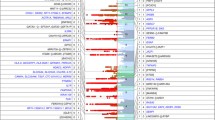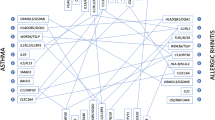Abstract
The past several years have seen an increase in the rate at which genes that are associated with allergic asthma and eczema are discovered. This review examines genetic association, gene expression, and functional studies that have identified genes that are expressed in the epithelial cells of the skin and lung and are involved in the pathogenesis of allergic asthma and eczema. This includes the genes encoding thymic stromal lymphopoietin (TSLP) and suppressor of cytokine signaling (SOCS3) that are involved in the activation of T-helper 2 cells, the microbial pattern recognition receptors nucleotide-binding oligomerization domain (NOD) genes (CARD4 and CARD15), Toll-like receptors (TLR2 and TLR4), and filaggrin, a protein required for effective barrier defense of the skin. Therefore, the development of allergic disease involves both the adaptive and innate immune systems, and the expression of these genes in the skin and lungs suggests a link to environmental triggers at body surfaces.
Similar content being viewed by others
References and Recommended Reading
Sugiura H, Ebise H, Tazawa T, et al.: Large-scale DNA microarray analysis of atopic skin lesions shows overexpression of an epidermal differentiation gene cluster in the alternative pathway and lack of protective gene expression in the cornified envelope. Br J Dermatol 2005, 152:146–149.
Smith FJ, Irvine AD, Terron-Kwiatkowski A, et al.: Loss-of-function mutations in the gene encoding filaggrin cause ichthyosis vulgaris. Nat Genet 2006, 38:337–342.
Palmer CN, Irvine AD, Terron-Kwiatkowski A, et al.: Common loss-of-function variants of the epidermal barrier protein filaggrin are a major predisposing factor for atopic dermatitis. Nat Genet 2006, 38:441–446.
Weidinger S, Illig T, Baurecht H, et al.: Loss-of-function variations within the filaggrin gene predispose for atopic derm atitis with allergic sensitizations. J Allergy Clin Immunol 2006, 118:214–219.
Irvine AD, McLean WH: Breaking the (un)sound barrier: filaggrin is a major gene for atopic dermatitis. J Invest Dermatol 2006, 126:1200–1202.
Illi S, von Mutius E, Lau S, et al.: The natural course of atopic dermatitis from birth to age 7 years and the association with asthma. J Allergy Clin Immunol 2004, 113:925–931.
Strober W, Murray PJ, Kitani A, Watanabe T: Signalling pathways and molecular interactions of NOD1 and NOD2. Nat Rev Immunol 2006, 6:9–20.
Inohara N, Ogura Y, Fontalba A, et al.: Host recognition of bacterial muramyl dipeptide mediated through NOD2. Implications for Crohn’s disease. J Biol Chem 2003, 278:5509–5512.
Miceli-Richard C, Lesage S, Rybojad M, et al.: CARD15 mutations in Blau syndrome. Nat Genet 2001, 29:19–20.
Watanabe T, Kitani A, Murray PJ, Strober W: NOD2 is a negative regulator of Toll-like receptor 2-mediated T helper type 1 responses. Nat Immunol 2004, 5:800–808.
McGovern DP, Hysi P, Ahmad T, et al.: Association between a complex insertion/deletion polymorphism in NOD1 (CARD4) and susceptibility to inflammatory bowel disease. Hum Mol Genet 2005, 14:1245–1250.
Daniels SE, Bhattacharrya S, James A, et al.: A genome-wide search for quantitative trait loci underlying asthma. Nature 1996, 383:247–250.
Ober C, Tsalenko A, Parry R, Cox NJ: A second-generation genomewide screen for asthma-susceptibility alleles in a founder population. Am J Hum Genet 2000, 67:1154–1162.
Laitinen T, Daly MJ, Rioux JD, et al.: A susceptibility locus for asthma-related traits on chromosome 7 revealed by genome-wide scan in a founder population. Nat Genet 2001, 28:87–91.
Weidinger S, Klopp N, Rummler L, et al.: Association of NOD1 polymorphisms with atopic eczem a and related phenotypes. J Allergy Clin Immunol 2005, 116:177–184.
Hysi P, Kabesch M, Moffatt MF, et al.: NOD1 variation, immunoglobulin E and asthma. Hum Mol Genet 2005, 14:935–941.
Kabesch M, Peters W, Carr D, et al.: Association between polymorphisms in capsase recruitment domain containing protein 15 and allergy in two German populations. J Allergy Clin Immunol 2003, 111:813–817.
Weidinger S, Klopp N, Rummler L, et al.: Association of CARD15 polymorphisms with atopy-related traits in a population-based cohort of Caucasian adults. Clin Exp Allergy 2005, 35:866–872.
Girardin SE, Jehanno M, Mengin-Lecreulx D, et al.: Identification of the critical residues involved in peptidoglycan detection by Nod1. J Biol Chem 2005, 280:38648–38656.
Voss E, Wehkamp J, Wehkamp K, et al.: NOD2/CARD15 mediates induction of the antimicrobial peptide human beta-defensin-2. J Biol Chem 2006, 281:2005–2011.
Yang D, Chertov O, Bykovskaia SN, et al.: Beta-defensins: linking innate and adaptive immunity through dendritic and T cell CCR6. Science 1999, 286:525–528.
Masumoto J, Yang K, Varambally S, et al.: Nod1 acts as an intracellular receptor to stimulate chemokine production and neutrophil recruitment in vivo. J Exp Med 2006, 203:203–213.
Netea MG, Kullberg BJ, de Jong DJ, et al.: NOD2 mediates anti-inflammatory signals induced by TLR2 ligands: implications for Crohn’s disease. Eur J Immunol 2004, 34:2052–2059.
van Heel DA, Ghosh S, Butler M, et al.: Synergistic enhancement of Toll-like receptor responses by NOD1 activation. Eur J Immunol 2005, 35:2471–2476.
Eder W, Klimecki W, Yu L, et al.: Toll-like receptor 2 as a major gene for asthma in children of European farmers. J Allergy Clin Immunol 2004, 113:482–488.
Yang IA, Barton SJ, Rorke S, et al.: Toll-like receptor 4 polymorphism and severity of atopy in asthmatics. Genes Immun 2004, 5:41–45.
Ahmad-Nejad P, Mrabet-Dahbi S, Breuer K, et al.: The tel-like receptor 2 R753Q polymorphism defines a subgroup of patients with atopic dermatitis having severe phenotype. J Allergy Clin Immunol 2004, 113:565–567.
Hertz CJ, Wu Q, Porter EM, et al.: Activation of Toll-like receptor 2 on human tracheobronchial epithelial cells induces the antimicrobial peptide human beta defensin-2. J Immunol 2003, 171:6820–6826.
Beisswenger C, Kandler K, Hess C, et al.: Allergic airway inflammation inhibits pulmonary antibacterial host defense. J Immunol 2006, 177:1833–1837.
Ong PY, Ohtake T, Brandt C, et al.: Endogenous antimicrobial peptides and skin infections in atoptic dermatitis. N Engl J Med 2002, 347:1151–1160.
Soumelis V, Reche PA, Kanzler H, et al.: Human epithelial cells trigger dendritic cell mediated allergic inflammation by producing TSLP. Nat Immunol 2002, 3:673–680.
Ito T, Wang YH, Duramad O, et al.: TSLP-activated dendritic cells induce an inflammatory T helper type 2 cell response through OX40 ligand. J Exp Med 2005, 202:1213–1223.
Wang YH, Ito T, Homey B, et al.: Maintenance and polarization of human TH2 central memory T cells by thymic stromallymphopoietin-activated dendritic cells. Immunity 2006, 24:827–838.
Ying S, O’Connor B, Ratoff J, et al.: Thymic stromal lymphopoietin expression is increased in asthmatic airways and correlates with expression of Th2-attracting chemokines and disease severity. J Immunol 2005, 174:8183–8190.
Al-Shami A, Spolski R, Kelly J, et al.: A role for TSLP in the development of inflammation in an asthma model. J Exp Med 2005, 202:829–839.
Yoo J, Omori M, Gyarmati D, et al.: Spontaneous atopic dermatitis in mice expressing an inducible thymic stromal lymphopoietin transgene specifically in the skin. J Exp Med 2005, 202:541–549.
Kurz T, Hoffjan S, Hayes MG, et al.: Fine mapping and positional candidate studies on chromosome 5p13 identify multiple asthma susceptibility loci. J Allergy Clin Immunol 2006, 118:396–402.
Seki Y, Inoue H, Nagata N, et al.: SOCS-3 regulates onset and maintenance of T(H)2-mediated allergic responses. Nat Med 2003, 9:1047–1054.
Bradley M, Soderhall C, Luthman H, et al.: Susceptibility loci for atopic dermatitis on chromosomes 3, 13, 15, 17 and 18 in a Swedish population. Hum Mol Genet 2002, 11:1539–1548.
Cookson WO, Ubhi B, Lawrence R, et al.: Genetic linkage of childhood atopic dermatitis to psoriasis susceptibility loci. Nat Genet 2001, 27:372–373.
Blumenthal MN, Langefeld CD, Beaty TH, et al.: A genome-wide search for allergic response (atopy) genes in three ethnic groups: Collaborative Study on the Genetics of Asthma. Hum Genet 2004, 114:157–164.
Ekelund E, Saaf A, Tengvall-Linder M, et al.: Elevated expression and genetic association links the SOCS3 gene to atopic dermatitis. Am J Hum Genet 2006, 78:1060–1065.
Horiuchi Y, Bae SJ, Katayama I: Overexpression of the suppressor of cytokine signalling 3 (SOCS3) in severe atopic dermatitis. Clin Exp Dermatol 2006, 31:100–104.
Laitinen T, Polvi A, Rydman P, et al.: Characterization of a common susceptibility locus for asthma-related traits. Science 2004, 304:300–304.
Vendelin J, Pulkkinen V, Rehn M, et al.: Characterization of GPRA, a novel G protein-coupled receptor related to asthma. Am J Respir Cell Mol Biol 2005, 33:262–270.
Kormann MS, Carr D, Klopp N, et al.: G-Protein-coupled receptor polym orphisms are associated with asthma in a large German population. Am J Respir Crit Care Med 2005, 171:1358–1362.
Feng Y, Hong X, Wang L, et al.: G protein-coupled receptor 154 gene polymorphism is associated with airway hyperresponsiveness to methacholine in a Chinese population. J Allergy Clin Immunol 2006, 117:612–617.
Bernier V, Stocco R, Bogusky MJ, et al.: Structure/function relationships in the neuropeptide S receptor: molecular consequences of the asthma-associated mutation N107I. J Biol Chem 2006, 281:24704–24712.
Veal CD, Reynolds NJ, Meggitt SJ, et al.: Absence of association between asthma and high serum immunoglobulin E associated GPRA haplotypes and adult atopic dermatitis. J Invest Dermatol 2005, 125:399–401.
Allen IC, Pace AJ, Jania LA, et al.: Expression and function of NPSR1/GPRA in the lung before and after induction of asthma-like disease. Am J Physiol Lung Cell Mol Physiol 2006, 291:L1005–1017.
Kang TJ, Chae GT: Detection of Toll-like receptor 2 (TLR2) mutation in the lepromatous leprosy patients. FEMS Immunol Med Microbiol 2001, 31:53–58.
Author information
Authors and Affiliations
Corresponding author
Rights and permissions
About this article
Cite this article
Jones, G. Susceptibility to asthma and eczema from mucosal and epidermal expression of distinctive genes. Curr Allergy Asthma Rep 7, 11–17 (2007). https://doi.org/10.1007/s11882-007-0025-z
Published:
Issue Date:
DOI: https://doi.org/10.1007/s11882-007-0025-z




